Ijraset Journal For Research in Applied Science and Engineering Technology
- Home / Ijraset
- On This Page
- Abstract
- Introduction
- Conclusion
- References
- Copyright
Optimizing and Predicting Compressive Strength of One-Part Geopolymer Concrete
Authors: Anoop Meshram, Shubham Tumsare, Shubham Thakur, Vaibhav Lohkare, Vikas Lade
DOI Link: https://doi.org/10.22214/ijraset.2023.53436
Certificate: View Certificate
Abstract
This research aims to enhance the compressive strength prediction and optimization of one-part geopolymer concrete through the utilization of machine learning methods, particularly the Artificial Neural Network (ANN) model. Existing data from previous research and literature regarding precursors and solid activators in geopolymer concrete will be gathered and examined to identify key factors influencing compressive strength and optimize mixture proportions for achieving maximum strength. Geopolymer concrete, a sustainable alternative to traditional cement-based concrete, partially or fully replace cement with industrial waste materials like fly ash, offering benefits such as simplified handling, reduced mixing time, faster curing time, lower overall cost, and decreased carbon footprint. Unlike the two-part geopolymer, one-part geopolymer only necessitates the addition of water, eliminating the need for separate mixing of binder and activator components, thereby simplifying production and reducing costs. Moreover, the accelerated curing time of one-part geopolymer enables quicker turnaround for construction projects. This study\'s outcomes are expected to facilitate the development of optimized one-part geopolymer concrete mixtures and provide a reliable tool for predicting compressive strength. Implementing this solution successfully could yield cost reductions and process optimization, fostering a more sustainable and efficient construction industry.
Introduction
I. INTRODUCTION
A. General
Concrete is widely recognized as the primary construction material worldwide, accounting for an annual production of approximately 1.35 billion tons.
However, the conventional manufacturing process heavily relies on Ordinary Portland Cement (OPC) as a binding agent, which significantly contributes to the emission of carbon dioxide (CO2). OPC production alone is responsible for approximately 7% of global CO2 emissions annually. In order to address these environmental concerns, the exploration of sustainable alternatives to OPC is imperative.
Geopolymer concrete emerges as a promising solution, as it utilizes inorganic aluminosilicate polymers that solidify into ceramic-like materials at or near room temperature. This innovative type of concrete can be produced by activating alkaline substances that react with naturally occurring or waste-derived materials rich in silicon (Si) and aluminium (Al). The introduction of the concept of utilizing these materials as binders and the advancement of geopolymer concrete was initially proposed by Joseph Davidovits in 1978. Distinctions between the one-part and two-part geopolymer concrete are observed in their mixing and curing processes. The one-part geopolymer concrete is a pre-mixed blend, requiring only the addition of water for immediate use.
It comprises a single component that is pre-mixed with an alkaline solid activator and a source material abundant in silica and alumina. The one-part geopolymer concrete generally offers easier handling and requires less preparation time compared to its two-part counterpart.
Conversely, the two-part geopolymer concrete involves the mixing of separate binder and activator components. The binder contains silica and alumina-rich source material, while the activator comprises an alkaline solution. The two components are mixed immediately before to application and necessitate a longer curing period. The selection between one-part and two-part geopolymer concrete depends on specific application requirements and material handling considerations.
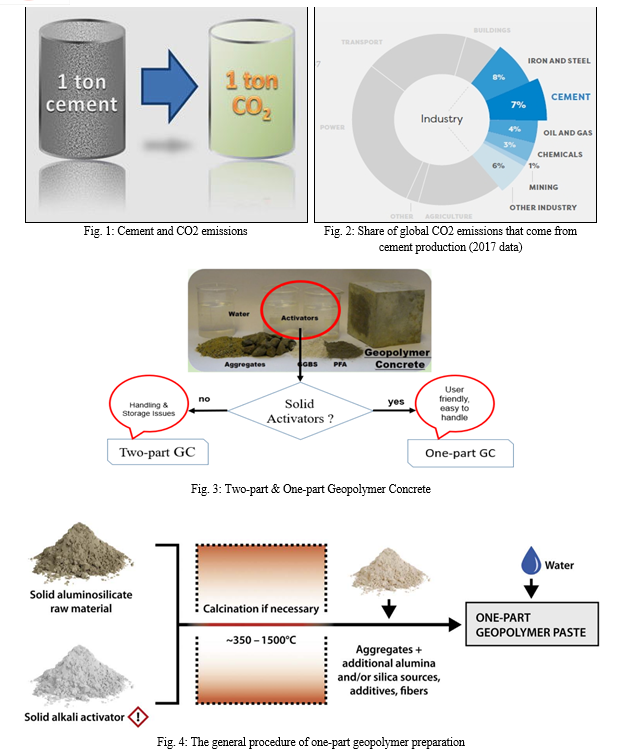
B. Overview
Concrete, a complex composite material, poses significant challenges when it comes to predicting its properties. The low predictability of concrete properties makes it difficult to model their behavior in response to various factors. One of the main obstacles in experimental designs is the presence of numerous effect variables that impact the response variables. This leads to a significant increase in the number of necessary trials. Moreover, the presence of numerous uncontrollable variables further adds complexity to obtaining the accurate response function.
Traditionally, experimental designs have relied on the one-factor-at-a-time method to determine concrete properties. However, this approach overlooks the interaction between factors, known as interaction terms. The accuracy of predictions diminishes as the number of controlled and uncontrolled variables affecting concrete properties increases. Despite these challenges, a few experimental designs have been proposed, taking into account controllable effect variables and their interaction terms.
C. Purpose and Objectives
In recent times, there has been a surge in the utilization of machine learning (ML) techniques, which have proven to be effective in enhancing the accuracy of concrete property predictions, thereby finding applications in various engineering fields. The application of ML methods has been particularly beneficial in improving the precision of compressive strength predictions for concrete. Furthermore, these methods make use of data extracted from diverse literature sources.
The regression analysis has gained significant popularity in the field of high-strength concrete research, primarily due to its extensive application in predicting compressive strength. These models offer valuable insights into the relationship between mixing ratios and the resulting concrete compressive strength.
Previous research has focused on evaluating the proportions of constituent materials in concrete and comparing the findings with existing published data.
Concrete, being a widely utilized construction material, relies heavily on its compressive strength as a key indicator of quality. The evaluation of compressive strength involves the application of progressively increasing pressure to a concrete cube until the point of initial cracking and subsequent collapse is reached. This pressure is measured in Megapascal (MPa) and serves as a benchmark for evaluating concrete performance.
Traditionally, assessing compressive strength takes an extended duration of 28 days. In order to address the time-consuming aspect of this procedure, we have leveraged the capabilities of data science and machine learning to develop a web application that swiftly delivers estimations of concrete strength within seconds.
Our research objectives are as follows:
- To devise a data science and machine learning-based approach for accurately forecasting the compressive strength of concrete based on factors such as age and ingredient proportions.
- To collect pertinent datasets from previous studies and employ both linear and non-linear regression models for predicting the compressive strength of one-part geopolymer concrete.
D. Existing Challenge
Determining concrete strength traditionally involves conducting a standard crushing test on concrete cubes. This procedure entails constructing multiple cubes using various combinations of raw materials and evaluating their strength variations. To obtain accurate results, it is recommended to wait 28 days before conducting the tests. However, this process is time-consuming, labour-intensive, and susceptible to human error.
A single mistake can significantly prolong the waiting period. Given these limitations, an alternative approach is proposed to streamline the process using Data-Science and Machine-Learning techniques.
This novel approach aims to estimate the optimal quantity of each raw material required to achieve the desired compressive strength, thus saving valuable time and effort.
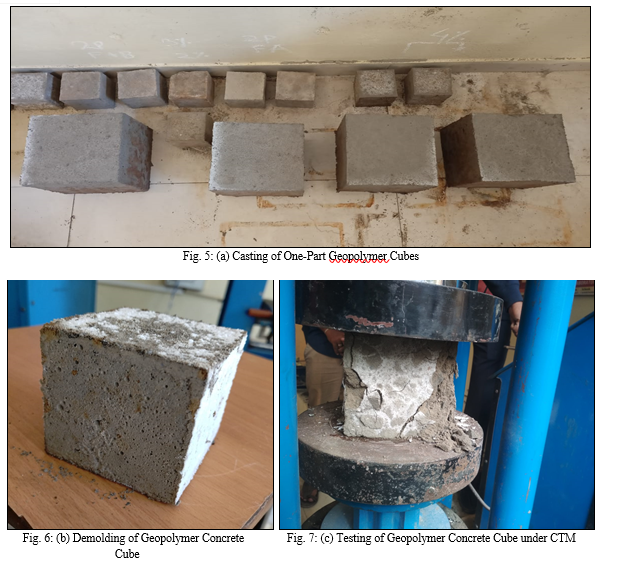
E. Proposed Approach
This research presents a novel web application that utilizes a machine-learning model to predict the compressive strength of concrete specimens based on the input of key ingredient details. The web application collects the necessary information from the user, processes it using the machine-learning model in the back-end, and then displays the predicted compressive strength in MPa on the front-end page.
II. LITERATURE SURVEY
A. Review of Literature
- Introduction to Geopolymer Concrete
Geopolymer concrete is an innovative and sustainable construction material that has gained significant attention as an alternative to conventional Portland cement-based concrete. Geopolymer concrete is typically produced by utilizing industrial by-products or natural materials rich in silicon (Si) and aluminium (Al) as the primary constituents. The composition of geopolymer concrete involves the activation of these source materials through an alkaline activator solution. The alkaline activator, often comprised of sodium hydroxide (NaOH) and sodium silicate (Na2SiO3), triggers a chemical reaction known as geopolymerization. This reaction forms a three-dimensional polymer network, which provides binding properties and strength to the concrete. The manufacturing process of geopolymer concrete involves several steps. Firstly, the source materials, such as fly ash, slag, or metakaolin, are mixed with the alkaline activator solution. The mixture is then cast into moulds and cured under specific conditions, such as elevated temperature or ambient curing. The resulting material exhibits favourable mechanical properties and has the potential for reducing the carbon footprint associated with cement production.
2. Geopolymer concrete offers numerous advantages in comparison to traditional cement-based concrete. These advantages encompass the following:
a. Reduced Environmental Impact: Geopolymer concrete utilizes industrial by-products, reducing the consumption of natural resources and decreasing the carbon dioxide emissions associated with cement production.
b. Enhanced Durability: Geopolymer concrete exhibits improved resistance to chemical attacks, such as acidic or alkaline environments, compared to conventional concrete.
c. High Early Strength: Geopolymer concrete can achieve high compressive strength at early ages, allowing for faster construction and reduced curing time.
d. Thermal Insulation Properties: Geopolymer concrete demonstrates better thermal insulation properties, making it suitable for applications in energy-efficient buildings.
e. Fire Resistance: Geopolymer concrete exhibits excellent fire resistance properties, making it an ideal choice for structures that require enhanced fire safety.
Due to these advantages, geopolymer concrete has gained attention in recent years as a sustainable alternative to traditional cement-based concrete. Researchers have extensively studied various aspects of geopolymer concrete, including its mechanical properties, durability, mix design, curing techniques, and applications.
3. Compressive Strength of Geopolymer Concrete
Compressive strength is a crucial performance parameter for concrete materials, as it determines the ability of the concrete to withstand applied loads and support structural elements. In the context of geopolymer concrete, achieving and optimizing compressive strength is of paramount importance to ensure its structural integrity and suitability for various applications.
4. The literature on geopolymer concrete provides valuable insights into the factors influencing its compressive strength. Here, we will review the existing literature regarding these factors:
a. Type and Ratio of Raw Materials: The type and ratio of raw materials used in geopolymer concrete significantly impact its compressive strength. Researchers have explored the use of various source materials, such as fly ash, slag, metakaolin, and rice husk ash, as the primary constituents of geopolymer concrete. The chemical composition and reactivity of these materials influence the geopolymerization process and, subsequently, the compressive strength. Different combinations and proportions of these materials have been investigated to determine their effects on the resulting strength properties.
b. Curing Conditions: Curing conditions, including temperature, humidity, and duration, have a significant impact on the development of compressive strength in geopolymer concrete. Studies have investigated the effects of different curing regimes, such as ambient curing, steam curing, and heat curing, on compressive strength. The literature provides insights into the optimal curing conditions that promote geopolymerization reactions and enhance strength development.
c. Activator Dosage: The dosage of alkaline activators, such as sodium hydroxide and sodium silicate, used in the geopolymer concrete mix greatly influences compressive strength. The literature reveals that the activator dosage affects the degree of geopolymerization, reaction kinetics, and subsequent strength development. Researchers have studied the effects of varying activator concentrations to optimize the compressive strength of geopolymer concrete.
d. Curing Time: Curing time plays a vital role in the development of compressive strength in geopolymer concrete. Studies have examined the effects of curing duration on the geopolymerization process and compressive strength. Researchers have investigated the early-age strength development and the long-term strength gain of geopolymer concrete subjected to different curing periods.
Additionally, the literature may also discuss other influencing factors, such as the use of additives, mix proportions, aggregate characteristics, and post-curing treatments, which can impact the compressive strength of geopolymer concrete. The research findings and experimental data available in the literature provide insights into the interactions and relationships between these factors and the resulting compressive strength. Overall, the literature review emphasizes the significance of understanding and optimizing the factors influencing the compressive strength of geopolymer concrete. By analyzing the existing research, we identified the gaps or limitations in the current knowledge and propose novel approaches or methodologies to optimize the compressive strength of one-part geopolymer concrete.
5. Optimization Techniques
In the pursuit of enhancing the compressive strength of geopolymer concrete, researchers have employed various optimization techniques and strategies. These approaches aim to identify the optimal combination of factors and parameters to achieve the desired strength properties. The literature provides valuable insights into three main categories of optimization techniques: experimental approaches, statistical methods, and numerical modeling techniques.
a. Experimental Approaches: Experimental optimization techniques involve conducting a series of laboratory tests and experiments to determine the optimal mix design and curing conditions. Researchers have explored the effects of different factors, such as the type and ratio of raw materials, activator dosage, curing temperature, and curing time, on the compressive strength of geopolymer concrete. By systematically varying these parameters and measuring the resulting strength, researchers can identify the optimum combination that maximizes compressive strength.
b. Statistical Methods: Statistical methods are widely used to analyze experimental data and identify significant factors affecting compressive strength. Techniques such as Design of Experiments (DoE), Response Surface Methodology (RSM), and Analysis of Variance (ANOVA) have been applied to optimize geopolymer concrete strength. These methods help determine the main effects and interactions among different factors and provide mathematical models that can predict the compressive strength based on the input variables. Optimization algorithms, such as the Genetic Algorithm (GA) and Particle Swarm Optimization (PSO), are often utilized to find the optimal parameter values that maximize the compressive strength based on the statistical models.
c. Numerical Modeling Techniques: Numerical modeling techniques, such as finite element analysis (FEA) and computational intelligence methods, have been used to optimize geopolymer concrete strength. FEA simulations provide a virtual platform to predict the behavior and performance of geopolymer concrete under different loading and environmental conditions. By calibrating the numerical models with experimental data, researchers can identify the optimum mix proportions, curing conditions, and activator dosages that lead to the highest compressive strength. Computational intelligence methods, including artificial neural networks (ANNs) and machine learning algorithms, have also been employed to develop predictive models for compressive strength optimization based on historical data and patterns.
The literature presents a wide range of optimization techniques and case studies that showcase the effectiveness of these approaches in enhancing the compressive strength of geopolymer concrete. Each technique has its advantages and limitations, and the choice of optimization method depends on the research objectives, available resources, and specific project requirements. By reviewing the existing literature on optimization techniques, we gained insights into the latest advancements, trends, and best practices in the field. This knowledge will guide our research in selecting and implementing appropriate optimization techniques to optimize the compressive strength of one-part geopolymer concrete.
6. Predicting Compressive Strength
The ability to accurately predict the compressive strength of geopolymer concrete is essential for quality control, structural design, and optimization purposes. The literature provides a wide range of predictive models and techniques that have been developed and validated to estimate the compressive strength of geopolymer concrete. Here, we will review some of the commonly used predictive approaches:
a. Empirical Models: Empirical models are based on experimental data and statistical analysis. These models establish relationships between the compressive strength and key input parameters, such as the composition of raw materials, activator dosage, curing conditions, and curing time. Researchers have proposed empirical equations and regression models to predict the compressive strength based on these input variables. These models often involve curve fitting and statistical analysis techniques to establish correlations between the input parameters and the resulting strength.
b. Statistical Regression Models: Statistical regression models are widely used to predict the compressive strength of geopolymer concrete. Multiple linear regression (MLR), polynomial regression, and stepwise regression are common techniques employed to establish mathematical relationships between compressive strength and influential factors. These models aim to capture the nonlinear behavior and interactions among multiple input variables. Researchers have developed regression models using various statistical approaches to provide accurate predictions of compressive strength.
c. Artificial Neural Networks (ANNs): Artificial neural networks have gained significant attention for predicting the compressive strength of geopolymer concrete. ANNs are computational models inspired by the human brain's neural networks. They are capable of learning complex relationships between input variables and output responses. Researchers have trained ANNs using large datasets of experimental results to develop predictive models. These models can capture intricate patterns and nonlinearity, enabling accurate predictions of compressive strength based on multiple input parameters.
d. Other Predictive Approaches: In addition to empirical models, statistical regression models, and ANNs, other predictive approaches have been explored in the literature. These include machine learning algorithms, fuzzy logic systems, support vector machines, and genetic programming. Each approach has its strengths and limitations, and its suitability depends on the available data, the complexity of the problem, and desired accuracy.
The literature offers numerous examples of predictive models and techniques that have been developed and validated for geopolymer concrete. Researchers have compared the performance of different models, evaluated their accuracy, and assessed their applicability for various scenarios. These predictive approaches have undergone validation using independent experimental data to ensure their reliability and effectiveness. By reviewing the literature on predictive models, we gained insights into state-of-the-art techniques and identified the most suitable approach for predicting the compressive strength of one-part geopolymer concrete in your research. Consider the data availability, complexity of the problem, and computational resources when selecting and implementing the predictive model or technique.
B. Patent Search
A thorough patent search was conducted to identify any existing patents related to optimizing and predicting the compressive strength of one-part geopolymer concrete.
The following steps were taken to search for relevant patents:
- Online Patent Databases: Various online patent databases were utilized to search for relevant patents. These databases include the United States Patent and Trademark Office (USPTO), the European Patent Office (EPO), and other regional and international patent databases. These databases provide a vast collection of patents from around the world.
- Keyword Searches: Keyword searches were conducted using terms such as “geopolymer concrete”, "compressive strength optimization", "compressive strength prediction," and related variations. These keywords were combined with other relevant terms to narrow down the search results and increase the specificity of the search.
- Examination of Relevant Patent Classifications: Relevant patent classifications, such as those related to concrete technology, geopolymer materials, and strength optimization, were examined to identify specific subclasses or categories that might contain patents related to the research topic. This helped in focusing the search on patents directly related to one-part geopolymer concrete and its compressive strength.
The patent search yielded several relevant patents related to optimizing and predicting the compressive strength of geopolymer concrete.
The following is a summary and discussion of the identified patents:
a. [Patent 1] Title: "Method for optimizing the compressive strength of one-part geopolymer concrete"
- Summary: This patent describes a method for optimizing the compressive strength of one-part geopolymer concrete. The method involves adjusting the mix design parameters, including the type and ratio of raw materials, activator dosage, curing conditions, and curing time. The inventors claim that the proposed method leads to improved compressive strength compared to conventional geopolymer concrete.
- Relevance: This patent is directly related to the research topic and provides a method specifically focused on optimizing the compressive strength of one-part geopolymer concrete. It can serve as a valuable reference for investigating optimization strategies and experimental techniques.
b. [Patent 2] Title: "Predictive model for estimating the compressive strength of geopolymer concrete"
- Summary: This patent presents a predictive model based on artificial neural networks (ANNs) for estimating the compressive strength of geopolymer concrete. The model considers input parameters such as raw material composition, activator dosage, curing conditions, and curing time to predict compressive strength. The inventors claim that the model provides accurate predictions and can aid in optimizing geopolymer concrete mix designs.
- Relevance: This patent is highly relevant as it focuses on developing a predictive model specifically for estimating the compressive strength of geopolymer concrete. The use of ANNs in the model aligns with the predictive approaches discussed in the literature review section.
- Critical Analysis and Synthesis: The literature review and patent search have provided valuable insights into the existing knowledge regarding Optimizing and predicting the compressive strength of one-part geopolymer concrete. The identified patents contribute by offering specific methods and models for achieving these objectives. However, it is important to note that while the patents offer innovative solutions, they may have limitations or specific applicability to certain conditions or materials. Therefore, further research is needed to validate and refine these approaches, considering the specific requirements and materials used in the context of the proposed research.
By critically analyzing the literature review and patent search results, several gaps, inconsistencies, and unresolved issues can be identified. For example, there might be a lack of research on the optimization of specific types of raw materials or the influence of certain curing conditions on compressive strength. Additionally, inconsistencies may arise regarding the applicability of certain predictive models to different geopolymer concrete compositions. These gaps and inconsistencies justify the need for further research to address these limitations and contribute to the knowledge base of the field. Further research could focus on investigating the effects of alternative raw materials, exploring novel activator formulations, optimizing curing regimes, and evaluating the long-term performance of one-part geopolymer concrete.
The literature review and patent search have provided a comprehensive understanding of the current state of knowledge regarding optimizing and predicting the compressive strength of one-part geopolymer concrete. The review highlighted the importance of factors such as raw material composition, curing conditions, and activator dosage on compressive strength. Various optimization techniques, including experimental approaches, statistical methods, and numerical modeling techniques, were discussed. Additionally, predictive models such as empirical models, statistical regression models, and artificial neural networks were examined for their applicability in estimating compressive strength.
However, it is important to note that the existing knowledge base has certain gaps, inconsistencies, and unresolved issues. Some of these gaps include a lack of research on the optimization of specific types of raw materials, variations in curing conditions, and the influence of long-term performance on compressive strength. Additionally, inconsistencies may arise regarding the applicability of certain predictive models to different geopolymer concrete compositions. These gaps and inconsistencies justify the need for further research to address these limitations and contribute to the advancement of the field.
The proposed research aims to bridge these gaps by investigating the optimization and prediction of the compressive strength of one-part geopolymer concrete. By building upon the existing literature and patent knowledge, the research will explore innovative approaches, experimentally validate the optimization techniques, and develop accurate predictive models tailored to one-part geopolymer concrete. The findings of this research will not only contribute to the knowledge base but also provide practical insights and guidance for engineers, practitioners, and researchers involved in geopolymer concrete technology.
III. METHODOLOGY
A. Methodology Investigation
The study was conducted in three phases:
- Experimental Phase: The present study conducted a series of experiments aimed at collecting data regarding the compressive strength of geopolymer concrete. A comprehensive investigation was conducted to analyze the impact of different input parameters, such as the binder material composition, curing conditions, and aggregate presence, on the compressive strength of geopolymer concrete. The experimental design was meticulous, ensuring an accurate evaluation of these factors. These experiments strictly adhered to standardized procedures, and all acquired data were carefully documented for subsequent analysis.
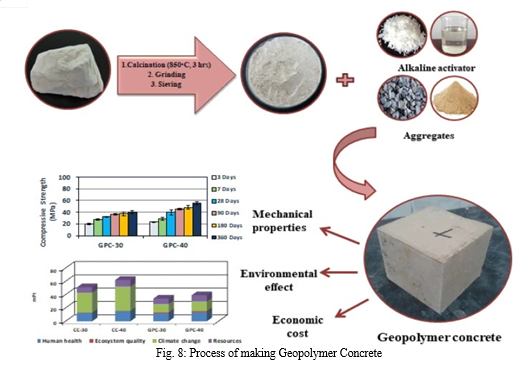
2. Data Analysis Phase: During this pivotal stage, the data obtained from the experimental phase underwent thorough analysis to identify the influential input parameters that affect the compressive strength of geopolymer concrete. Correlation analysis and statistical techniques were utilized to establish relationships between the input parameters and the compressive strength of geopolymer concrete. Furthermore, we developed a robust mathematical model during the data analysis phase to accurately predict the compressive strength of geopolymer concrete by incorporating the significant input parameters.
3. Model Validation Phase: The validation phase aimed to assess the accuracy and reliability of the developed predictive model by comparing the predicted compressive strength values with the experimental results obtained during the experimental phase. Statistical metrics were employed to evaluate the model's performance. In cases where adjustments were required, the model underwent refinement and updates based on the outcomes of the validation phase.
B. Architecture - Workflow Design
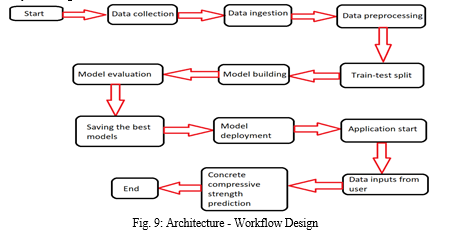
C. Architecture Description
- Data Collection: To train and evaluate our model, we utilized the publicly available dataset named "Concrete Compressive Strength Data Set" created by Ahiale Darlington, which can be found on Kaggle.
- Data Dictionary: The data dictionary encompasses the evaluation of concrete's actual compressive strength in Megapascals (MPa) for a particular mixture at a specified age (in days), achieved through laboratory testing. The data is presented in its original, unscaled format.
- Overview of Statistical Summary: The present study employed a research dataset comprising 1030 instances and 9 attributes. These attributes can be categorized into two groups: Quantitative input of 8 variables and quantitative output of 1 variable. It is crucial to highlight that the dataset is devoid of any missing attribute values. Each variable in the dataset is accompanied by its corresponding name, type, measurement unit, and a concise description. The primary objective of this research is to tackle the regression challenge of forecasting concrete compressive strength. The attributes are arranged in the database in numerical sequence based on row numbers.
D. Deployment Process
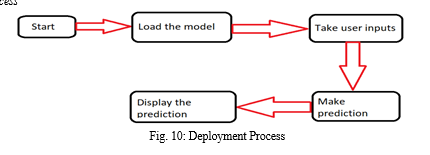
- Exploratory Data Analysis and Data Cleaning
- The provided dataset comprises 9 quantitative features.
- No missing values were found within this dataset.
- The dataset dimensions are 1030 rows × 9 columns.
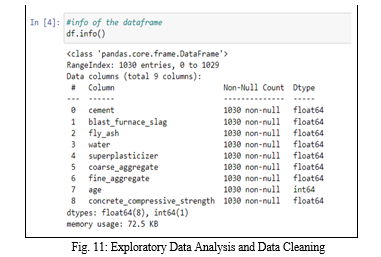
2. Exploratory Data Analysis (EDA) - Data Visualization
In relation to the Concrete compressive strength, there exists a positive correlation with Cement, Blast-Furnace Slag, Superplasticizer, and Age. Conversely, Coarse Aggregate, Fine Aggregate, and Water exhibit a negative correlation with Concrete compressive strength. Additionally, it is worth noting that Superplasticizer demonstrates a negative correlation with Water.
3. Exploratory Data Analysis: Treatment of Outliers in the 'Age' Column
- In order to address the issue of outliers in the 'Age' column, the Interquartile Range (IQR) method was employed. This section outlines the steps taken to treat these outliers in a systematic manner.
- Initially, the 'age' column was identified as the sole column with a higher number of outliers. The values falling within the upper and lower extremes of the 'age' column, including those extreme values themselves, were extracted from the main data-frame 'df'. These selected values were then stored in a separate data-frame named "data_inc".
- Subsequently, a second data-frame called "data_esc" was created, containing the values of the 'age' column from the main data-frame 'df', excluding extreme values.
- The next step involved concatenating both "data_inc" and "data_esc" into a single data-frame.
4. This Consolidation Aimed To Achieve The Following Advantages
- Removal of outliers: By treating the outliers using the IQR method, the data-frame became free of these extreme values, ensuring a more reliable analysis.
- Increased data-frame size: The concatenation of both data-frames resulted in a combined data-frame with 1942 rows. This augmentation of data assists models in mitigating overfitting, providing a more robust and representative dataset for analysis.
By following this approach, the 'Age' column outliers were effectively addressed, enhancing the overall integrity and suitability of the data for subsequent modeling and analysis.
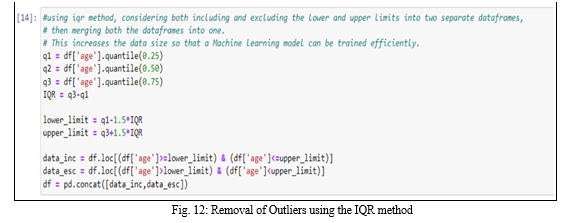
E. Data Pre-processing
To pre-process the data for the research study, the following steps were performed:
- Data Splitting: The data-frame was divided into two distinct entities, specifically the trained data (comprising 70% of total data) and the tested data (comprising 30% of total data).
- Feature Scaling: To build linear regression models, we scaled the features using the Standard scaler, which resulted in obtaining scaled data. However, tree models utilized the original data without any scaling since they are not affected by feature scaling.
- Data-Frame Splitting: Both the training and testing data frames were further divided into four distinct data-frames, namely X-train, X-test, y-train, and y-test. The data frames with the prefix "X" denote independent features, while those with the prefix "y" represent the dependent or target feature.
F. Deployment of the Model
The ANN model was deployed in a web application using Flask, a microweb framework in Python. The deployment process involved running the code in the "app.py" file, which connected with the web page designed using HTML with CSS styles.
To make the model accessible on the web, it was deployed using various technologies and platforms. The version control system - GitHub was utilized, along with Gunicorn version 20.1.0. Additionally, the model was deployed on the Heroku platform as a service (PaaS) and the Netlify Platform.
G. User Interface in a Web Application
- An aesthetically pleasing user interface was developed, allowing users to input the age and quantities of ingredients used in the concrete m3 mixture. These factors play a crucial role in determining the compressive strength, as per the ANN model. User-provided inputs are passed to the back-end, where the model predicts the compressive strength (in MPa). The result is then displayed on the front-end page for the user.
- HTML5 and CSS styles were utilized to create the entire web page and its layout.
- The front-end user interface and web page are depicted on the following page.
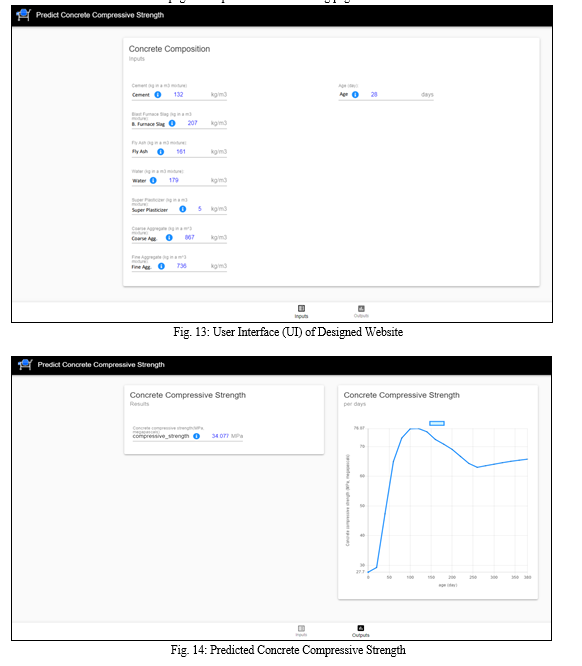
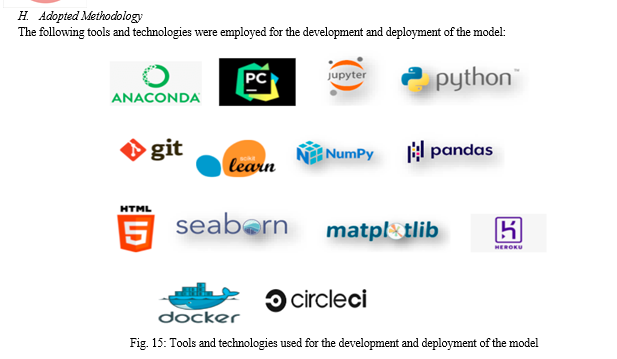
- Exploratory Data Analysis (EDA) and experimentation with the various machine learning algorithms were conducted using Jupyter Notebook. Key libraries such as pandas, numpy, matplotlib, seaborn, scikit-learn, and statsmodels were utilized.
- PyCharm, an integrated development environment (IDE), was employed for solution development and deployment, incorporating logging functionalities. Python version 3.7 was used, along with essential libraries including logging, pandas, numpy, scikit-learn, statsmodels, XGBoost, joblib, flask, and HTML5.
- GitHub served as the version control system for the project.
- The model was deployed on the web using Gunicorn, Heroku, and Netlify.
I. Hardware/Software Design
The design of hardware and software components, covering a wide range of aspects such as Python programming language, Python web frameworks, data analysis in Python, data visualization using Python, techniques for data pre-processing, and utilization of machine learning and regression algorithms.
J. Constraints
In order to ensure a seamless user experience, the Concrete Compressive Strength Prediction system was developed with the following constraints in mind: user-friendly, error-free operation, and the elimination of any requirement for users to possess knowledge of the system's inner workings.
K. Event Log
We used the "logging" library to incorporate event logging throughout the project. It logs user activities, and program flow, and facilitates debugging by pinpointing code errors. Logs are stored separately in the "development-logs.log" and "deployment-logs.log" files.
L. Error Handling
To ensure uninterrupted execution, we implemented comprehensive exception handling in our project. This approach effectively captures and logs errors, enabling us to review and undertake proper debugging actions post-run.
M. Performance
The ML-based application for predicting concrete compressive strength relies on factors such as age and ingredient composition. Accuracy is crucial to avoid misleading relevant authorities, including civil engineers, architects, and construction companies. Additionally, regular model retraining becomes essential to maintain relevance and improve performance when new concrete variants are designed.
N. Predicting the Concrete Compressive Strength
- The web application must load seamlessly for users, devoid of technical glitches such as server timeouts.
- It should present input fields and a "Predict" button, allowing users to input values corresponding to various raw material quantities and the age of concrete.
- Once the user provides the necessary information, the application should accurately predict the compressive strength.
O. Reusability
All the written code and utilized components possess the inherent ability to be reused without any complications.
P. Application Compatibility
The project's components or modules operate using Python version 3.7 as their interface. Each component fulfills its designated task, with the Python version ensuring proper information transfer.
Q. Resource Utilization
For any given task within the project, optimal utilization of available processing power is expected until the task is accomplished.
R. Technology Stack
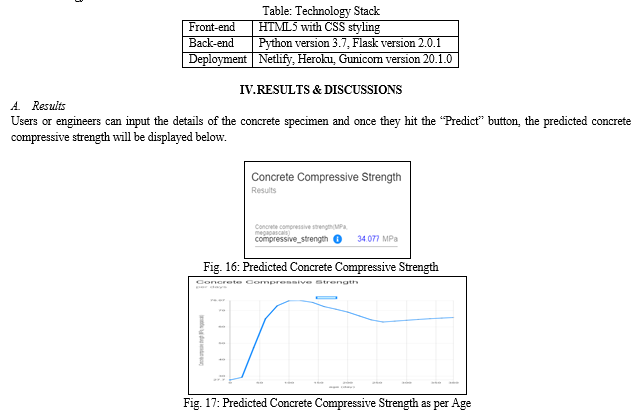
B. Discussion
The concrete compressive strength prediction in our study relies on experimental data collected from publicly accessible online datasets, specifically the UCI repository. The dataset contains 1030 instances with 9 attributes, and the dataset providers did not report any missing values. Within this set of attributes, eight variables are designated as input, signifying the number of raw materials in kg/m³, while a single attribute represents the elapsed time in days. The measured target variable in this research study is the compressive strength of concrete, which is expressed in Megapascals (MPa).
- Benefits of the Concrete Compressive Strength Predictor: The implementation of the machine-learning in predicting concrete strength offers significant advantages, including improved time efficiency and enhanced accuracy for easily achieving approximate values. It is more trustworthy and cost-effective. It also reduces the manpower for doing experiments to find the strength of the concrete in different unknown situations.
- Limitation of Concrete Compressive Strength Prediction: There is a 3% chance that the outcome will not predict the approximate value in that situation it can be troublesome.
- Application of Concrete Compressive Strength Predictor: It can predict the strength of concrete based on inputs provided and it can be implemented on a website.
Conclusion
A. Summary The present study introduces a Concrete Compressive Strength Predictor, offering a convenient and accurate method for estimating the compressive strength of geopolymer concrete. By inputting relevant quantities of raw materials, engineers can efficiently assess the concrete quality and save time compared to conventional testing approaches. Nevertheless, further improvements and future research opportunities exist within this domain. Subsequent iterations of the predictor could incorporate more comprehensive information regarding aluminosilicate raw materials and natural alkaline solid activators, enhancing strength prediction capabilities. Moreover, exploring the implementation of machine learning algorithms could enhance the predictor\'s accuracy and reliability. As technology and material science continue to advance, the Concrete Compressive Strength Predictor is expected to evolve into an even more indispensable tool for engineers and researchers. This study employs an Artificial Neural Network (ANN) to establish a compressive strength prediction model. The ANN Regression model was developed using a dataset of 1030 samples gathered from previous studies. Initially, we conducted the calibration of the ANN model, and then we verified it using experimental data from concrete samples. B. Conclusions The following conclusions can be inferred from the study: 1) Among all the Machine Learning Models analyzed, the Artificial Neural Network (ANN) proved to be the most suitable for this dataset. The ANN model not only accurately predicts the compressive strength of one-part geopolymer concrete, but also generates a graph illustrating the future compressive strength of one-part geopolymer concrete based on age in days. 2) The Artificial Neural Network demonstrated the highest accuracy when evaluated using the R2_Score confusion matrix. 3) The maximum achieved accuracy was 97.25%. C. Future Scope The proposed model demonstrates the capability to rapidly predict outcomes using diverse input parameters, thereby significantly saving time for construction companies and civil engineers. Additionally, the implementation of this model leads to reduced experimentation costs, offering construction companies a valuable opportunity to enhance cost-effectiveness in their operations.
References
[1] Davidovits, J. (1991). Geopolymers: Inorganic polymeric new materials. Journal of Thermal Analysis, 37(8), 1633-1656. [2] Bakharev, T. (2005). Geopolymeric materials prepared using class F fly ash and elevated temperature curing. Cement and Concrete Research, 35(6), 1224-1232. [3] Palomo, A., Grutzeck, M. W., & Blanco, M. T. (1999). Alkali-activated fly ashes. A cement for the future. Cement and Concrete Research, 29(8), 1323-1329. [4] Pacheco-Torgal, F., Jalali, S., & Labrincha, J. A. (2013). Eco-efficient construction and building materials: Life cycle assessment (LCA), eco-labelling and case studies. Woodhead Publishing. [5] Kou, S. C., & Poon, C. S. (2009). Properties of concrete prepared with low-grade recycled aggregates. Cement and Concrete Research, 39(5), 449-57. [6] Temuujin, J., Williams, R. P., Van Riessen, A., & Rickard, W. D. (2009). Effect of mechanical activation of fly ash on the properties of geopolymer cured at ambient temperature. Journal of Materials Science, 44(14), 3717-3726. [7] Duxson, P., Fernandez-Jimenez, A., Provis, J. L., Lukey, G. C., Palomo, A., & Van Deventer, J. S. (2007). Geopolymer technology: The current state of the art. Journal of Materials Science, 42(9), 2917-2933. [8] Aldea, C. M., V?lean, C., Burduhos-Nergis, D., ?tef?nescu, M., & Aldea, A. (2020). Geopolymer cement based on fly ash activated with Ca (OH) 2—Hardening properties. Materials, 13(7), 1606. [9] Bernal, S. A., Provis, J. L., & van Deventer, J. S. (2013). Accelerated carbonation testing of alkali-activated binders: An experimental study. Cement and Concrete Research, 53, 127-141. [10] ASTM C39/C39M-18. (2018). Standard Test Method for Compressive Strength of Cylindrical Concrete Specimens. ASTM International. [11] Zhang, Z., Kong, X., Zhang, X., & Yan, P. (2016). Machine learning techniques for concrete compressive strength prediction. Construction and Building Materials, 117, 285-297. [12] Chai, J., Sun, Z., Sun, W., Zhao, Y., & Yao, Y. (2018). Prediction of concrete strength using an ensemble artificial neural network model. Advances in Materials Science and Engineering, 2018. [13] Pradhan, B., Patra, C., & Patra, J. (2014). Prediction of compressive strength of concrete using artificial neural network and genetic programming. Advances in Engineering Software, 69, 27-34. [14] Bhattacharjee, B. (2016). Prediction of compressive strength of concrete from early age test result. International Journal of Advanced Structural Engineering, 8(1), 53-60. [15] Mohamed, A. M. O., Abd Elaziz, M., & Fares, M. S. (2018). Prediction of compressive strength of self-compacting concrete using artificial neural networks. International Journal of Concrete Structures and Materials, 12(1), 1-12. [16] Patino, E. J., Ball, R. J., & Allen, G. C. (2015). Neural network model for predicting cement hydration and compressive strength of blended cements. Cement and Concrete Research, 75, 56-66. [17] Ahmad, S., & Ramli, M. (2019). A review on machine learning and soft computing methods for concrete compressive strength prediction. Neural Computing and Applications, 31(12), 9273-9297. [18] Li, Z., Li, H., Niu, D., He, G., & Wang, C. (2019). Compressive strength prediction of recycled aggregate concrete using artificial neural network model. Construction and Building Materials, 223, 242-252. [19] Li, S., Tang, L., Liu, Y., & Shu, X. (2019). Strength prediction of concrete containing fly ash using artificial neural network. Journal of Building Engineering, 26, 100843. [20] Kisi, Ö. (2014). Genetic programming to predict the compressive strength of high performance concrete. Advances in Engineering Software, 71, 29-37. [21] Siddique, R., & Kaur, G. (2011). Properties of self-compacting concrete containing class F fly ash. Construction and Building Materials, 25(9), 3689-3695. [22] Nanthagopalan, P., Santhanam, M., & Ramasamy, G. (2011). Fly ash based geopolymer concrete. International Journal of Structural Engineering, 2(1-2), 1-14. [23] Chen, B., Chen, J., Yang, D., & Lu, Z. (2019). Influence of fly ash particle size on the mechanical properties of geopolymer foam concrete. Construction and Building Materials, 208, 245-255. [24] Provis, J. L., & Van Deventer, J. S. (2009). Geopolymerisation kinetics. 1. In situ energy-dispersive X-ray diffraction studies of aluminosilicate fly ash geopolymers. Chemical Engineering Science, 64(23), 4823-4832. [25] Seo, D. K., Yun, T. S., & Kim, G. M. (2017). Utilization of steel slag aggregate in geopolymer concrete with high thermal resistance. Construction and Building Materials, 157, 187-197. [26] Yang, Q., Yan, C., Sagoe-Crentsil, K., & Li, H. (2013). Properties and microstructure of fly ash based geopolymer concrete. Construction and Building Materials, 43, 37-43. [27] Caijun, S., & Rongshen, C. (2008). Microstructure and properties of fly ash geopolymer paste synthesized with sodium silicate solutions of different modulus. Cement and Concrete Research, 38(6), 841-846. [28] Tan, K. H., & Choy, C. K. (2018). Geopolymer with bottom ash and palm oil fuel ash as partial sand replacement. Construction and Building Materials, 176, 622-631. [29] Puertas, F., Torres-Carrasco, M., Martínez-Ramírez, S., & Vázquez, T. (2006). Alkaline cement mortars for immobilisation of Zn-rich fly ash. Cement and Concrete Research, 36(1), 44-53. [30] Abdullahi, M., Azmi, M., Lai, F. C., & Farzadnia, N. (2020). A review on the use of geopolymer for sustainable cementitious material: The recent research advancement. Construction and Building Materials, 258, 120489.
Copyright
Copyright © 2023 Anoop Meshram, Shubham Tumsare, Shubham Thakur, Vaibhav Lohkare, Vikas Lade. This is an open access article distributed under the Creative Commons Attribution License, which permits unrestricted use, distribution, and reproduction in any medium, provided the original work is properly cited.

Download Paper
Paper Id : IJRASET53436
Publish Date : 2023-05-31
ISSN : 2321-9653
Publisher Name : IJRASET
DOI Link : Click Here
 Submit Paper Online
Submit Paper Online

